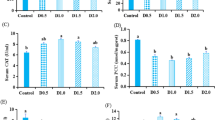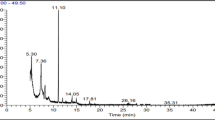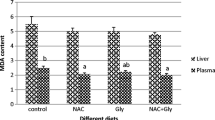Abstract
This study was conducted to examine the dietary ascorbic acid requirement and effects on growth performance, oxidative status, and disease resistance in juvenile grass carp (Ctenopharyngodon idella). Triplicate groups of 30 fish weighting 3.39 ± 0.03 g were fed with diets containing graded levels of ascorbic acid (18.9, 71.8, 118.7, 169.9, 321.1, and 618.5 mg kg−1) in a recirculating rearing system for 8 weeks. No significant differences in growth performance among all groups were observed (P > 0.05). Diet with 321.1 mg kg−1 ascorbic acid significantly increased the feed intake (P < 0.05). Meanwhile, the expression of liver peroxisome proliferator-activated receptors-γ and uncoupling protein 2 were significantly declined (P < 0.05). Subsequently, a challenge test was conducted by injection of Aeromonas hydrophila (2.4 × 105 CFU cells mL−1 per fish) and fish fed with ascorbic acid shown a better liver oxidation status (e.g., superoxide dismutase and glutathione peroxidase) than the control diet (P < 0.05). The optimum dietary ascorbic acid concentration was about 155 mg kg−1 basing on the oxidation status in liver. Nevertheless, the broken-line model indicated that the optimal level for juvenile grass carp is about 310 mg kg−1.









Similar content being viewed by others
References
Ai Q, Mai K, Tan B, Xu W, Zhang W, Ma H, Liu F (2006) Effects of dietary vitamin C on survival, growth, and immunity of large yellow croaker, Pseudosciaena crocea. Aquaculture 261:327–336
Arrigoni O, De Tullio MC (2002) Ascorbic acid: much more than just an antioxidant. BBA-Gen Subjects 1569:1–9
Atencio L, Moreno I, Jos A, Prieto AI, Moyano R, Blanco A, Camean AM (2009) Effects of dietary selenium on the oxidative stress and pathological changes in tilapia (Oreochromis niloticus) exposed to a microcystin-producing cyanobacterial water bloom. Toxicon 53:269–282
Barja G, Lopez-Torres M, Perez-Campo R, Rojas C, Cadenas S, Prat J, Pamplona R (1994) Dietary vitamin C decreases endogenous protein oxidative damage, malondialdehyde, and lipid peroxidation and maintains fatty acid unsaturation in the guinea pig liver. Free Radical Bio Med 17:105–115
Chavin KD, Yang S, Lin HZ, Chatham J, Chacko VP, Hoek JB, Walajtys-Rode E, Rashid A, Chen C, Huang C, Wu T, Lane MD, Diehl AM (1999) Obesity induces expression of uncoupling protein-2 in hepatocytes and promotes liver ATP depletion. J Biol Chem 274:5692–5700
Chen Y, Yuan R, Liu Y, Yang H, Liang G, Tian L (2015) Dietary vitamin C requirement and its effects on tissue antioxidant capacity of juvenile largemouth bass, Micropterus salmoides. Aquaculture 435:431–436
Daniel N, Muralidhar AP, P. Srivastava PP, Jain KK, Prasad KP, Manish J, Sivaramakrishnan T (2018) Dietary ascorbic acid requirement for growth of striped catfish, Pangasianodon hypophthalmus (Sauvage, 1878) juveniles. Aquac Nutr 24:616–624
Dass M, Garg K, Singh GB, Khanna SK (1994) Attenuation of benzanthrone toxicity by ascorbic acid in guinea pigs. Fundam Appl Toxicol 22:447–456
Eo J, Lee K (2008) Effect of dietary ascorbic acid on growth and non-specific immune responses of tiger puffer, Takifugu rubripes. Fish Shellfish Immun 25:611–616
Fattman CL, Schaefer LM, Oury TD (2003) Extracellular superoxide dismutase in biology and medicine. Free Radical Bio Med 35:236–256
Fulop P, Derdak Z, Sheets A, Sabo E, Berthiaume EP, Resnick MB, Wands JR, Paragh G, Baffy G (2006) Lack of UCP2 reduces fas-mediated liver injury in Ob/Ob mice and reveals importance of cell-specific UCP2 expression. Hepatology 44:592–601
Gan L, Li XX, Pan Q, Wu SL, Feng T, Ye H (2017) Effects of replacing soybean meal with faba bean meal on growth, feed utilization and antioxidant status of juvenile grass carp, Ctenopharyngodon idella. Aquac Nutr 23:192–200
Gouillou-Coustans MF, Bergot P, Kaushik SJ (1998) Dietary ascorbic acid needs of common carp (Cyprinus carpio) larvae. Aquaculture 161:453–461
Green JA, Hardy RW, Brannon EL (2002) Effects of dietary phosphorus and lipid levels on utilization and excretion of phosphorus and nitrogen by rainbow trout (Oncorhynchus mykiss). 1. Laboratory-scale study. Aquac Nutr 8:279–290
Hardie WD, Ebert J, Frazer M, Takahashi K, Badr K (1993) The effect of thromboxane A2 receptor antagonism on amphotericin B-induced renal vasoconstriction in the rat. Prostaglandins 45:47–56
Henrique M, Gomes EF, Gouillou-Coustans MF, Oliva-Teles A, Davies SJ (1998) Influence of supplementation of practical diets with vitamin C on growth and response to hypoxic stress of seabream, Sparus aurata. Aquaculture 161:415–426
Hu B, Li X, Leng X (2008) Effects of dietary vitamin C on growth, meat quality and non-specific immunity indices of grass carp, Ctenopharyngodon idellus. J Fishery Sci Chin 5:794–800. (In Chinese with English abstract. https://doi.org/10.3321/j.issn:1005-8737.2008.05.011)
Hu ZZ, Huang Z, Liao C (1988) Dietary vitamin C requirements of juvenile grass carp, Ctenopharyngodon idellus. Freshwater Fishery:12–14. (In Chinese)
Huang F, Jiang M, Wen H, Wu F, Liu W, Tian J, Shao H (2016) Dietary vitamin C requirement of genetically improved farmed Tilapia, Oreochromis Niloticus. Aquac Res 47:689–697
Leal E, Zarza C, Tafalla C (2017) Effect of vitamin C on innate immune responses of rainbow trout (Oncorhynchus mykiss) leukocytes. Fish Shellfish Immun 67:179–188
Li XX, Zhou LL, Mo HY, Pan Q, Gan L (2017) Interaction effects of dietary lipid and lysine on growth feed utilization and body composition of juvenile grass carp (Ctenopharyngodon idella). Aquacult Int 25:1591–1606
Liang X, Li Y, Hou Y, Qiu H, Zhou Q (2015) Effect of dietary vitamin C on the growth performance, antioxidant ability and innate immunity of juvenile yellow catfish (Pelteobagrus fulvidraco Richardson). Aquac Res 48:149–160
Lim C, Lovell RT (1978) Pathology of the vitamin C deficiency syndrome in channel catfish (Ictalurus punctatus). J Nutr 108:1137–1146
Lim P, Boey P, Ng W (2001) Dietary palm oil level affects growth performance, protein retention and tissue vitamin E concentration of African catfish, Clarias gariepinus. Aquaculture 202:101–112
Lin MF, Shiau SY (2004) Requirements of vitamin C (L-ascorbyl-2-monophosphate-Mg and L-ascorbyl-2-monophosphate-Na) and its effects on immune responses of grouper, Epinephelus malabaricus. Aquac Nutr 10:327–333
Lin MF, Shiau SY (2005) Dietary L-ascorbic acid affects growth, nonspecific immune responses and disease resistance in juvenile grouper, Epinephelus malabaricus. Aquaculture 244:215–221
Lushchak VI (2011) Environmentally induced oxidative stress in aquatic animals. Aquat Toxicol 101:13–30
Moran-Salvador E, Lopez-Parra M, Garcia-Alonso V, Titos E, Martinez-Clemente M, Gonzalez-Periz A, Lopez-Vicario C, Barak Y, Arroyo V, Claria J (2011) Role for PPAR gamma in obesity-induced hepatic steatosis as determined by hepatocyte and macrophage specific conditional knockouts. FASEB J 25:2538–2550
Ozaki M, Fuchinoue S, Teraoka S, Ota K (1995) The in vivo cytoprotection of ascorbic acid against ischemia/reoxygenation injury of rat liver. Arch Biochem Biophys 318:439–445
Pessayre D, Mansouri A, Fromenty B (2002) Nonalcoholic steatosis and steatohepatitis v. mitochondrial dysfunction in steatohepatitis. Am J Physiol-Gastr L 282:193–199. https://doi.org/10.1152/ajpgi.00426.2001
Pettinelli P, Videla LA (2011) Up-regulation of PPAR-gamma mRNA expression in the liver of obese patients: an additional reinforcing lipogenic mechanism to SREBP-1c induction. J Clin Endocr Metab 96:1424–1430
Ren DL, Collingwood TN, Rebar EJ, Wolffe AP, Camp HS (2002) PPAR gamma knockdown by engineered transcription factors: exogenous PPAR gamma 2 but not PPAR gamma 1 reactivates adipogenesis. Genes Dev 16:27–32
Ren T, Koshio S, Teshima S, Ishikawa M, Alam MS, Panganiban A, Moe YY, Kojima T, Tokumitsu H (2005) Optimum dietary level of L-ascorbic acid for Japanese eel, Anguilla japonica. J World Aquacult Soc 36:437–443
Sato P, Nishikimi M, Udenfriend S (1976) Is L-gulonolactone-oxidase the only enzyme missing in animals subject to scurvy? Biochem Bioph Res Co 71:293–299
Shahkar E, Yun H, Kim D, Kim S, Lee BL, Bai SC (2015) Effects of dietary vitamin C levels on tissue ascorbic acid concentration, hematology, non-specific immune response and gonad histology in broodstock Japanese eel, Anguilla japonica. Aquaculture 438:115–121
Shao L, Han D, Yang Y, Jin J, Liu H, Zhu X, Xie S (2018) Effects of dietary vitamin C on growth, gonad development and antioxidant ability of on-growing gibel carp (Carassius auratus gibelio var. CAS III). Aquac Res 49:1242–1249
Tian J, Lu R, Ji H, Sun J, Li C, Liu P, Lei C, Chen L, Du ZY (2015) Comparative analysis of the hepatopancreas transcriptome of grass carp (Ctenopharyngodon idellus) fed with lard oil and fish oil diets. Gene 565:192–200
Wang L, Chen D, Lou B, Zhan W, Chen R, Liu F, Mao G (2017) The effects of dietary vitamin C on growth performance, serum enzymes activities and resistance to Vibrio alginolyticus challenge of yellow drum Nibea albiflora. Aquac Res 48:4684–4695
Wang XJ, Kim KW, Bai SC (2002) Effects of different dietary levels of L-ascorbyl-2-polyphosphate on growth and tissue vitamin C concentrations in juvenile olive flounder, Paralichthys olivaceus (Temminck et Schlegel). Aquac Res 33:261–267
Wang XJ, Kim KW, Bai SC, Huh MD, Cho BY (2003) Effects of the different levels of dietary vitamin C on growth and tissue ascorbic acid changes in parrot fish (Oplegnathus fasciatus). Aquaculture 215:203–211
Xu H, Jiang W, Feng L, Liu Y, Wu P, Jiang J, Kuang S, Tang L, Tang W, Zhang Y, Zhou X (2016) Dietary vitamin C deficiency depressed the gill physical barriers and immune barriers referring to Nrf2, apoptosis, MLCK, NF-kappa B and TOR signaling in grass carp (Ctenopharyngodon idella) under infection of Flavobacterium columnare. Fish Shellfish Immun 58:177–192
Yuan X, Liang X, Liu L, Fang J, Li J, Li A, Cai W, Xue M, Wang J, Wang Q (2016) Fat deposition pattern and mechanism in response to dietary lipid levels in grass carp, Ctenopharyngodon idellus. Fish Physiol Biochem 42:1557–1569
Zhou Q, Wang L, Wang H, Xie F, Wang T (2012) Effect of dietary vitamin C on the growth performance and innate immunity of juvenile cobia (Rachycentron canadum). Fish Shellfish Immun 32:969–975
Funding
The work was financially supported by the funds of Guangdong Marine Economy Promotion Projects (MEPP) Fund (GDOE[2019]A, No. 26), Guangdong Provincial Special Fund For Modern Agriculture Industry Technology Innovation Teams, Department of Agriculture and Rurual Affairs of Guangdong Province (2019KJ150), National Natural Science Foundation of China (31202007), Administration of Ocean and Fisheries of Guangdong Province (A201601C08) and Guangdong Science and Technology Department (2016A020210072).
Author information
Authors and Affiliations
Corresponding author
Ethics declarations
Conflict of interest
The authors declare that they have no conflict of interest.
Ethical approval
All applicable international, national, and/or institutional guidelines for the care and use of animals were followed by the authors.
Additional information
Publisher’s note
Springer Nature remains neutral with regard to jurisdictional claims in published maps and institutional affiliations.
Qing Han and Hongbo Fan are co-first author.
Rights and permissions
About this article
Cite this article
Han, Q., Fan, H., Peng, J. et al. Ascorbic acid enhanced the growth performance, oxidative status, and resistance to Aeromonas hydrophila challenge of juvenile grass carp (Ctenopharyngodon idella). Aquacult Int 28, 15–30 (2020). https://doi.org/10.1007/s10499-019-00440-z
Received:
Accepted:
Published:
Issue Date:
DOI: https://doi.org/10.1007/s10499-019-00440-z




